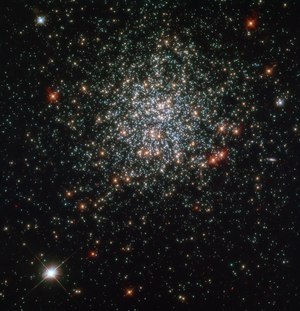NGC 2203
(c) ESA/Hubble, CC BY 4.0 | |
| Aufnahme mittels Hubble-Weltraumteleskops | |
| AladinLite | |
| Sternbild | Tafelberg |
| Position Äquinoktium: J2000.0 | |
|---|---|
| Rektaszension | 06h 04m 42,5s [1] |
| Deklination | −75° 26′ 18″ [1] |
| Erscheinungsbild | |
| Winkelausdehnung | 3.3' [2] |
| Physikalische Daten | |
| Zugehörigkeit | Große Magellansche Wolke? |
| Geschichte | |
| Entdeckt von | John Herschel |
| Entdeckungszeit | 23. Januar 1836 |
| Katalogbezeichnungen | |
| NGC 2203 • GC 1390 • h 3035 • | |
NGC 2203 ist ein offener Sternhaufen im Sternbild Mensa. Das Objekt wurde am 23. Januar 1836 von John Herschel entdeckt.[3]
Weblinks
Einzelnachweise
Auf dieser Seite verwendete Medien
(c) ESA/Hubble, CC BY 4.0
Stellar Sweet Shop
Looking its best ever is the star cluster NGC 2203, here imaged by the NASA/ESA Hubble Space Telescope. Aside from its dazzling good looks, this cluster of stars contains lots of astronomical treats that have helped astronomers puzzle together the lifetimes of stars.
A main sequence star, like our Sun, is the term applied to a star during the longest period of its life, when it burns fuel steadily. Our Sun’s fuel will run out in approximately 6 billion years, and it will then move on to the next stage of its life when it will turn into a red giant. Astronomers studying NGC 2203, which contais stars that are roughly twice as massive as our Sun, found that their rotation might be a factor as to why some of the stars stay longer than usual in this main-sequence phase of their life.
This is the best resolution obtained of the star cluster to date.
Credit:
ESA/Hubble & NASA, L. Girardi
CoordinatesPosition Position (RA): 6 4 39.02 Position (Dec): -75° 26' 0.45" Field of view: 2.57 x 2.67 arcminutes Orientation: North is 152.0° right of vertical
Colours & filters Band Wavelength Telescope Optical U 336 nm Hubble Space Telescope WFC3 Optical g 475 nm Hubble Space Telescope WFC3 Optical I 814 nm Hubble Space Telescope WFC3.

